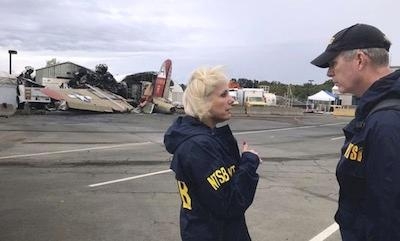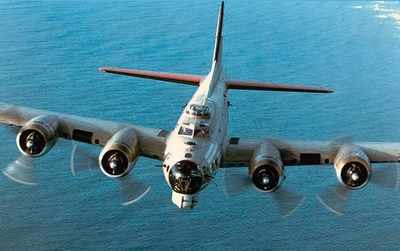Pilot Replied That The Airplane Had A 'Rough Mag' On The No. 4 Engine
The NTSB has released its preliminary report from the accident which occurred October 2 involving a Collings Foundation B-17 on a Living History flight during the organization's "Wings of Freedom" tour. Seven people were fatally injured in the accident, which occurred at Bradley International Airport (KBDL), Windsor Locks, Connecticut.

The airplane was destroyed during a precautionary landing and subsequent runway excursion. The commercial pilot, airline transport pilot, and five passengers were fatally injured. The flight mechanic/loadmaster and four passengers were seriously injured, while one passenger and one person on the ground incurred minor injuries.
On the morning of the accident flight, an airport lineman at BDL assisted the loadmaster as he added 160 gallons of 100LL aviation fuel to the accident airplane. The lineman stated that the accident airplane was the first to be fueled with 100LL fuel that day.
According to preliminary air traffic control (ATC) data provided by the FAA, shortly after takeoff, at 0950, one of the pilots reported to ATC that he wanted to return to the airport. At that time, the airplane was about 500 ft above ground level (agl) on the right crosswind leg of the airport traffic pattern for runway 6. The approach controller verified the request and asked if the pilot required any assistance, to which he replied no. The controller then asked for the reason for the return to the airport, and the pilot replied that the airplane had a "rough mag" on the No. 4 engine. The controller then instructed the pilot to fly a right downwind leg for runway 6 and confirmed that the flight needed an immediate landing. He subsequently cancelled the approach of another airplane and advised the pilot to proceed however necessary to runway 6.
The approach controller instructed the pilot to contact the tower controller, which he did. The tower controller reported that the wind was calm and cleared the flight to land on runway 6. The pilot acknowledged the landing clearance; at that time, the airplane was about 300 ft agl on a midfield right downwind leg for runway 6. The tower controller asked about the airplane's progress to the runway and the pilot replied that they were "getting there" and on the right downwind leg. No further communications were received from the accident airplane.
Witness statements and airport surveillance video confirmed that the airplane struck approach lights about 1,000 ft prior to the runway, then contacted the ground about 500 ft prior to the runway before reaching runway 6. It then veered right off the runway before colliding with vehicles and a deicing fluid tank about 1,100 ft right of the center of the runway threshold.
The wreckage came to rest upright and the majority of the cabin, cockpit, and right wing were consumed by postimpact fire. The landing gear was extended and measurement of the left and right wing flap jackscrews corresponded to a flaps retracted setting. The flap remained attached to the right wing and the aileron was consumed by fire. The flap and aileron remained attached to the left wing and a section of flap was consumed by fire. The empennage, elevator, and rudder remained intact. Control continuity was confirmed from the elevator, rudder, elevator trim, and rudder trim from each respective control surface to the area in the cabin consumed by fire, and then forward to the cockpit controls. Elevator trim and rudder trim cables were pulled during impact and their preimpact position on their respective drum at the control surfaces could not be determined. The left wing aileron trim tab remained intact and its pushrod was connected but bent. The left aileron bellcrank separated from the wing, but the
aileron cables remained attached to it and the aileron cable remained attached in cockpit.

The Nos. 1 and 2 engines remained partially attached to the left wing and all three propeller blades remained attached to each engine. One propeller blade attached to engine No. 1 exhibited an 8-inch tip separation; the separated section traveled about 700 ft before coming to rest near an airport building. Another propeller blade on the No. 1 engine exhibited chordwise scratching and leading edge gouging. The third propeller blade was bent aft. The No. 2 engine propeller blades exhibited leading edge gouges and chordwise scratches.
The No. 3 engine was recovered from the top of the deicing tank. One blade was impact damaged and near the feather position. The other two blades appeared in a position between low pitch and feather. One propeller blade exhibited a 5-inch tip separation and the separated tip sections were recovered from 100 ft and 700 ft from the main wreckage. The No. 4 engine was recovered from the deice building. All three propeller blades on the No. 4 engine appeared in the feather position.
The wreckage was retained for further examination.
A fuel sample was able to be recovered from one of the No 3. engine's two fuel tanks. The recovered sample had a visual appearance and smell consistent with 100LL aviation fuel and was absent of debris or water contamination. Following the accident, the fuel truck used to service the airplane was quarantined and subsequent testing revealed no anomalies of the truck's equipment or fuel supply. Additionally, none of the airplanes serviced with fuel from the truck before or after the accident airplane, including another airplane operated by the Collings Foundation, reported any anomalies.
The pilot held a commercial pilot certificate with ratings for airplane single-engine land, airplane multiengine land, instrument airplane, and held a type rating for the B-17. In addition, he held a mechanic certificate with airframe and powerplant ratings. His most recent FAA second-class medical certificate was issued on January 9, 2019. At that time, he reported a total flight experience of 14,500 hours.
The co-pilot held an airline transport pilot certificate with ratings for airplane single-engine land, airplane multiengine land, and instrument airplane, with type ratings for B-737, B-757, B-767, DC-10, and LR-Jet. In addition, he held a flight engineer certificate as well as a flight instructor certificate with ratings for airplane single-engine and instrument airplane. His most recent FAA second-class medical certificate was issued on January 8, 2019. At that time, he reported a total flight experience of 22,000 hours.
The airplane was manufactured in 1944. It was issued a limited airworthiness certificate in 1994, and equipped with passenger seats in 1995. It was powered by four Wright R-1820-97, 1,200- horsepower engines, each equipped with a three-blade, constant-speed Hamilton Standard propeller. The airplane was maintained under an airworthiness inspection program, which incorporated an annual inspection, and 25-hour, 50-hour, 75-hour, and 100-hour progressive inspections. Review of maintenance records revealed that the airplane's most recent annual inspection was completed on January 16, 2019. At that time, the airframe had accumulated about 11,120 total hours of operation. Engine Nos. 1, 2, and 3 had 0 hours since major overhaul at that time. Engine No. 4 had 838.2 hours since major overhaul at that time. The airplane's most recent progressive inspection, which was the 100-hour inspection, was completed on September 23, 2019. At that time, the airplane had been operated about 268 hours since the annual
inspection.
(Source: NTSB. Images from file)
 ANN's Daily Aero-Term (05.01.24): Say Altitude
ANN's Daily Aero-Term (05.01.24): Say Altitude ANN's Daily Aero-Linx (05.01.24)
ANN's Daily Aero-Linx (05.01.24) Classic Aero-TV: Korean War Hero Twice Reborn
Classic Aero-TV: Korean War Hero Twice Reborn Airborne 04.29.24: EAA B-25 Rides, Textron 2024, G700 Deliveries
Airborne 04.29.24: EAA B-25 Rides, Textron 2024, G700 Deliveries Airborne Affordable Flyers 05.02.24: Bobby Bailey, SPRG Report Cards, Skydive!
Airborne Affordable Flyers 05.02.24: Bobby Bailey, SPRG Report Cards, Skydive!




